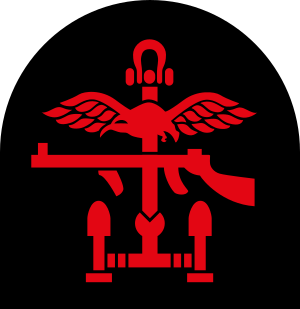Inter-Service Training and Development Centre facts for kids
The Inter-Service Training and Development Centre (ISTDC) was a special group created by the British military leaders before World War II. Its main job was to figure out new ways and create new equipment for "Combined Operations". This meant working together as a team, with the Royal Navy, Army, and Royal Air Force all playing a part.
The ISTDC started in May 1938. It brought together experts from the Navy, Army, and Air Force. Their goal was to develop better methods and tools for different military branches to work together.
Why the ISTDC Was Needed
For a long time, the British military, especially the Royal Navy, had been landing soldiers on enemy shores. This is called an amphibious operation. Famous examples include landings in Quebec in 1759 and Zeebrugge in 1918.
However, after the costly Gallipoli campaign in World War I, many thought these types of operations were too difficult. Also, money was tight because of a worldwide economic problem called the Great Depression. This meant there wasn't much money to develop new equipment for these landings.
Despite these challenges, military experts kept discussing the importance of amphibious operations. They knew that Britain might need to land troops on enemy beaches again.
In 1936, a group at the Royal Naval Staff College suggested creating two new organizations. One would be a permanent committee, and the other would be a training and development center. This center would focus on combined operations.
So, in May 1938, the military leaders set up the Inter-Services Training and Development Centre (ISTDC). It was located at Fort Cumberland, near Portsmouth. The ISTDC had officers from the Navy, Army, and Air Force. They also had a budget of £30,000 to get started.
The first officers at the ISTDC were:
- Captain Loben Edward Harold Maund (Navy), who led the ISTDC from July 1938 to September 1939.
- Major MWM MacLeod (Army).
- Wing Commander Guy Knocker (Royal Air Force).
- Captain Peter-Picton-Phillips (Royal Marines), who served as the assistant.
How the ISTDC Worked
The ISTDC operated for a short but important time, from May 1938 to mid-1942. It had direct access to top military leaders and intelligence groups. This allowed them to get advice from many different departments.
For example, they talked to naval engineers about ship designs. They also contacted private companies to help design special boats. The ISTDC even worked with scientists to create things like floating smoke bombs.
The Centre was given specific problems to solve. These included:
- How to land troops from the air.
- How to deliver supplies by air.
- Designing special boats to land tanks.
- How to organize a beach landing.
- Creating floating piers to help troops get ashore.
- Designing special ships to act as command centers.
- Developing tanks that could move on land and water.
- Figuring out how to deal with underwater obstacles.
- How to land water and fuel.
- Using small boats for quick raids.
By the end of 1939, the ISTDC had created a clear plan for how to carry out beach landings. This plan was very important. It was later used as the basic strategy for major landings like Operation Torch and Operation Husky during World War II.
The ISTDC staff searched everywhere for materials and ideas. They ran many experiments to find the best ways to attack from the sea. They identified fast cargo ships that could be turned into "Landing Ships Infantry." These ships could carry a whole battalion of soldiers and some vehicles. They were set aside for use if war broke out.
In March 1942, Louis Mountbatten became the new Chief of Combined Operations (CCO). Soon after, the ISTDC was reorganized. Parts of it became new departments under the Chief of Combined Operations.
Important Achievements
The ISTDC made many important contributions to combined operations. Their work helped the British military prepare for the challenges of World War II.
Some of their key accomplishments and inventions include:
- Assault Landing Craft: Small boats designed to quickly land soldiers on beaches.
- Mechanized Landing Craft (LCM 1): Larger boats designed to carry vehicles and equipment.
- Landing Craft Tank (Mk. 1): They helped design these special boats to land tanks directly onto beaches.
- Manual on Combined Operations: A guide that explained how to plan and carry out combined operations.
- Infra-red directional beacons: Devices that helped landing craft find their way accurately to the beach at night.
- Landing Craft crew training base: They helped set up a training center for the crews of landing craft.
- Support Landing Craft (LCS(1), LCS(2)): Small boats designed to provide fire support during landings.
- Standard Naval Bombardment Code: A system for coordinating naval gunfire during landings.
- Land/Sea Smoke Generating devices: Equipment to create smoke screens on land or water to hide movements.
- Floating Piers (pontoons): Temporary bridges made of floating sections to help troops and vehicles get from landing craft to shore.
- Landing Ship Infantry: They identified and helped adapt ships like the HMS Glengyle to carry troops and landing craft for large-scale landings.


